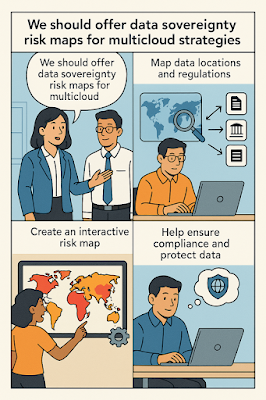How to Offer Data Sovereignty Risk Maps for Multicloud Strategies
How to Offer Data Sovereignty Risk Maps for Multicloud Strategies
Managing data sovereignty is becoming one of the most critical concerns for organizations pursuing multicloud strategies.
Every cloud provider, region, and data type introduces a different legal landscape.
Without a clear visual framework, companies risk severe compliance breaches, regulatory fines, and reputational damage.
Table of Contents
- What Is Data Sovereignty Risk Mapping?
- Why It Matters in Multicloud Environments
- Key Components of an Effective Risk Map
- Steps to Build Data Sovereignty Risk Maps
- Best Tools and Platforms
- Final Thoughts
What Is Data Sovereignty Risk Mapping?
Data sovereignty risk mapping is the process of identifying where organizational data is stored, processed, or transmitted, and understanding the legal implications associated with each jurisdiction.
It involves creating a visual map or dashboard that highlights countries, data types, storage locations, and regulatory frameworks.
This visibility enables decision-makers to manage legal risks and maintain compliance with local, regional, and international laws.
Why It Matters in Multicloud Environments
With multicloud strategies, data is often distributed across multiple vendors, regions, and infrastructures.
This complexity heightens exposure to different regulations such as GDPR in Europe, CCPA in California, and PDPA in Singapore.
Organizations that fail to account for data sovereignty risk may find themselves unintentionally breaching laws simply because data resides in an unexpected region.
Key Components of an Effective Risk Map
To be useful, a data sovereignty risk map should include:
Data Location Metadata: Clear documentation of where every data set is hosted.
Jurisdiction-Specific Regulations: Laws and standards applicable to each location.
Risk Levels: Visual indicators (color coding, heatmaps) showing high-risk vs low-risk areas.
Data Types: Differentiation between PII, financial data, healthcare records, etc.
Update Mechanisms: Systems to keep the map dynamic and updated as new regulations emerge or cloud providers shift storage models.
Steps to Build Data Sovereignty Risk Maps
Here's a structured approach to building a functional data sovereignty risk map:
Step 1: Data Discovery and Classification
Use discovery tools to scan all your multicloud environments.
Classify data according to sensitivity and regulatory requirements.
Step 2: Map Data Locations
Identify all storage, backup, and processing locations.
Document which cloud providers and services are involved.
Step 3: Overlay Regulatory Frameworks
Map out the applicable laws for each jurisdiction where data is stored or transmitted.
Highlight specific risks like data residency mandates or cross-border transfer restrictions.
Step 4: Visualize and Automate
Create an interactive dashboard using visualization tools like Power BI, Tableau, or specialized cloud governance platforms.
Automate data updates and regulatory intelligence where possible.
Best Tools and Platforms
Several solutions can simplify the creation and management of sovereignty risk maps:
Microsoft Purview: An excellent data governance platform offering advanced data discovery, classification, and mapping.
OneTrust DataGovernance: Helps automate compliance tracking across multicloud setups.
BigID: Offers deep data discovery and mapping features suitable for complex cloud environments.
For further learning, check out this practical guide:
Final Thoughts
Offering data sovereignty risk maps is no longer optional for companies operating in multicloud ecosystems.
It is a critical strategy for ensuring legal compliance, securing sensitive information, and maintaining customer trust across global operations.
By proactively visualizing risks, organizations can make smarter, faster decisions and future-proof their multicloud investments.
Start today by auditing your data locations, mapping out jurisdictional risks, and leveraging automation tools to keep your maps dynamic and accurate!
Keywords: Data Sovereignty, Multicloud Strategy, Risk Mapping, Cloud Compliance, Data Residency
